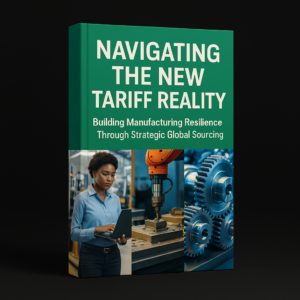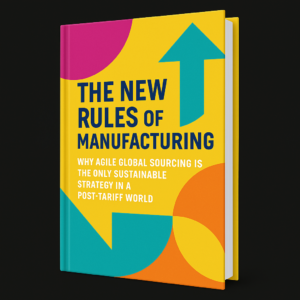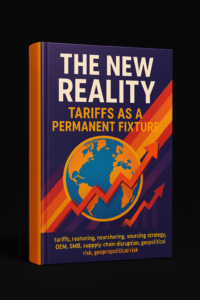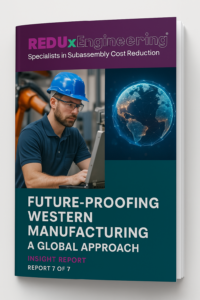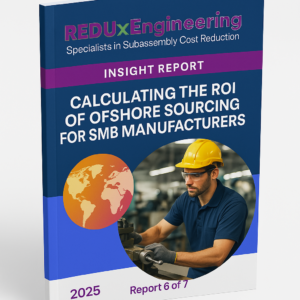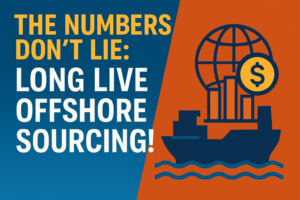
American Tech & Hardgoods Manufacturers Still Enjoy Big Gains from Selective Offshore Sourcing…and Those Gains Will Only Grow.
For Western Europe, Canada, the UK, Australia and New Zealand, it’s a Clear Path to Stable, Enhanced Profits and a Strong Tariff Mitigation Strategy for Your US Sales.
After the announcements of April 2nd in the Whitehouse Rose Garden (You can see a full table of the tariffs below), the average US small to medium-sized tech and hardgoods manufacturer was probably thinking, “Offshore Sourcing is Dead!”
Not so fast!
Let’s set the stage with some real numbers and some short and mid-term considerations:
- Labor Rate Comparison:
The fully loaded manufacturing labor charge out rates on contract manufacturing agreements in China are approximately $15.00 USD per hour. That includes everything: benefits, holidays, facilities, support staff…the whole enchilada.
In India, that rate is $7.00 USD and in Vietnam it is $6.00 USD.
The equivalent fully loaded average manufacturing labor rate in the US is calculated as follows:
Average hourly rate for production and nonsupervisory employees in 2025, according to the US Bureau of Labor & Statistics (https://www.bls.gov/news.release/empsit.nr0.htm?utm_source=chatgpt.com ) is: $30.89 USD. But this is not an equivalent “fully loaded” rate. To get that number we must:
Add 25% for benefits, vacation, insurance, etc.: $30.89 USD + $7.72 = $38.61
Then we need to multiply this by two or three to account for the supporting staff, the facility costs, the capex, etc.: $38.61 x 2 = $77.22 USD up to $38.61 x 3 = $115.83.
So, the comparable offshore vs. US loaded hourly labor rates are:

That’s between 4 to 11 times as much per hour for loaded labor costs in the US.
Think about that.
- Parts and Material Costs
On average, the parts and materials required for the manufacturing of hardgoods, and tech are 30% more expensive to source in the US than the equivalent parts and materials in China.

- Manufacturing Capacity, Capabilities and Modernity
Over the last four decades, the manufacturing infrastructure, capital investment and buildout in China has been relentless and intense. The result is a vast and modern industry 4.0 manufacturing complex that specializes in metal, electrical and plastic/composite manufacturing at a level of capacity, sophistication, cost efficiency and quality that cannot currently be achieved elsewhere.
In Vietnam, the last decade has seen trillions invested in Vietnams electronics manufacturing infrastructure, leveraging lessons learned in China and leading-edge technologies. That resulted in tier-1 contract manufacturing facilities that are the most modern in the world, delivering a level of capacity, sophistication, cost efficiency, and quality that cannot be currently achieved anywhere else.
Facilities of this magnitude do not currently exist in North America, as evidenced by Apple’s recent announcement to invest $500 billion in the United States over the next four years. (https://www.apple.com/newsroom/2025/02/apple-will-spend-more-than-500-billion-usd-in-the-us-over-the-next-four-years/?utm_source=chatgpt.com ).
So, when the tariffs are implemented in a few short days, and US manufacturers rush to onshore, where does all that “instant manufacturing capacity” come from.
It will conservatively take 20 years and trillions in capital spending to meet the new demand. In the meantime:
- Lead times will become wildly unpredictable and unbearably long.
- Contract manufacturing rates will skyrocket, due to supply and demand.
- Quality will inevitably suffer under the strain of unbearable demand.
- The trillions in capex and build-out must be recovered from somewhere. Even when completed, the new domestic manufacturing capacity will carry a LARGE premium for years to come.
Eventually the inevitable winds of political change will blow, and a new regime will enter the Whithouse and remove the tariffs. Then, how will all that onshore investment and cost stand up to lower rates overseas. How will those who adopted the exclusive onshore strategy survive?
- Bottom Line: Landed Subassembly Cost Comparison
So, with all that said, let’s look at some hard numbers.
For printed circuit board assemblies, plastic or composite parts, and metal parts, the average split between labor and materials is:

It is generally accepted that the minimum gross margin % needed to keep a manufacturing company viable is 40%. Comparing both China and The Philippines to onshore manufacturing we have the following results:
Manufacturers in the USA (Post Liberation Day Tariffs):
0% – 33% Savings

Manufacturers in Canada, Western Europe, The UK, Australia and New Zealand:
19% – 49% Savings

- A Long-Term Profit Protection & Growth Strategy for US Tech & Hardgoods Manufacturers
Offshore sourcing to China, the Philippines and other low-cost/high tech manufacturing hubs is guaranteed to deliver US tech and hardgoods manufacturers:
- A minimum ongoing net 0%-33% savings on parts and subassemblies in the short, medium and long term.
- A large capacity, advanced industry 4.0, teir-1 manufacturing infrastructure of electronics, metal, and plastic/composites in the short and medium term.
- This infrastructure has been built out over the last 30 years with few, if any, comparables in the USA today, which cannot be replicated onshore quickly.
- More stable lead times and pricing in the short and medium term.
- A rush to onshore in the US, where the infrastructure has yet to be built out, will rapidly lead to maxing out current contract manufacturing capacity.
- A spike in demand, with limited supply will inevitably lead to longer lead times, lower quality, and much higher pricing by the existing domestic contract manufacturers.
- At the same time, the gap left by onshoring will open up capacity offshore, leading to better lead times, lower pricing and even better quality. This trend will lead to enhanced savings and profits for manufacturers who employ offshore sourcing.
- Enhanced profits and competitive positioning for your international target markets.
- Exclusive onshoring to the US will expose the manufacturer to the retaliatory tariffs on any products that they seek to sell into international markets leaving them uncompetitive with shrinking market share or profits.
- Adopting a global sourcing strategy allows the US-based manufacture to drop-ship directly from their offshore CM to their international markets, eliminating exposure to reciprocal tariffs.
- An inevitable shift back to 19% – 49% pre-tariff savings as US political cycles bring new administrations into the White House.
- For those who chose an onshore strategy, the impact of this inevitable cycle will be devastating, leaving them in an untenable, uncompetitive position.
The bottom line is that adopting an offshore sourcing strategy, for US tech and hardgoods manufacturers, is a guaranteed break-even with a strong savings potential. It also protects their international sales from reciprocal tariffs. Lead times, pricing and quality will remain stable. Done right, with the support of REDUx Engineering, there is no downside.
There is, however, a significant opportunity at an enhanced upside, as US contract manufacturing capacity maxes out, prices begin to rise, lead times grow, and quality is sacrificed. These factors will only grow the savings gap and leave those who adopted offshore sourcing in a growing position of competitive advantage.
- A Long-Term Manufacturing Strategy for Tech & Hardgoods Manufacturers in Canada, Western Europe, The UK, Australia and New Zealand
With 19% – 49% savings on parts and subassemblies, offshore sourcing, done right, is a clear winner for SME hardgoods and tech manufacturers in higher cost western countries, regardless of their global target markets.
With the blanket 10% tariff on your sales into the US, the 19% – 49% savings on parts and subassemblies, realized through a safe and efficient offshore sourcing strategy, is the difference between losing 10% off your profit line for all US sales and gaining 9% to 39% on those same sales.
The best part is, that you can achieve these savings with very little burden on your organization, and no up-front capex or cost, by taking advantage of REDUx Engineering’s contingency-based managed offshore sourcing programs.
The alternative is to build out a US manufacturing presence, at significant capex, cost, organizational burden and risk, with the most likely outcome being net losses for the foreseeable future. By the time losses do turn, the tariff environment will have changed, leaving you with an expensive fixed international infrastructure to maintain.
The Proof is in the Pudding:
Within 48 hours of the Tariffs being announced, U.S. President Donald Trump and Vietnam’s leader To Lam agreed to discuss a deal to remove tariffs, both leaders said, after a phone call that Trump said was “very productive”, as Hanoi escalated its campaign to dodge duties of 46%.
“Just had a very productive call with To Lam, General Secretary of the Communist Party of Vietnam, who told me that Vietnam wants to cut their Tariffs down to ZERO if they are able to make an agreement with the U.S.”, Trump wrote on his Truth social platform.

Conclusion:
American tech & hardgoods manufacturers still enjoy big gains from selective offshore sourcing…and those gains will only grow.
For Western Europe, Canada, the UK, Australia and New Zealand, diversified, global offshore sourcing of parts and subassemblies is a clear path to stable, enhanced profits and a fast and effective tariff mitigation strategy for your US sales.
Making it Safe, Flexible and Successful:
REDUxEngineering can be your “Managed Offshore Sourcing” department, providing SMB manufacturers the on-demand specialized expertise, pre-vetted CM partners. multiple international destinations, language skills, long-term regional relationships and on-site QA staff needed to safely, efficiently, and quickly tap into the savings that diversified global sourcing has delivered to multi-nationals for decades. Hop on our calendar for a 20 minute briefing: https://app.apollo.io/#/meet/david_orton_b36 , or email us with times that work for you: [email protected].


